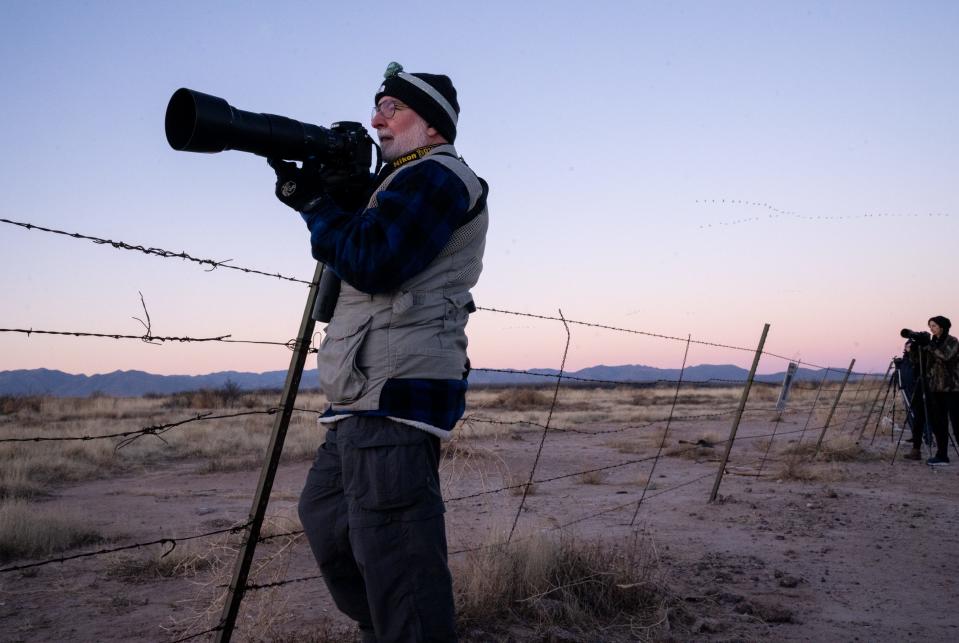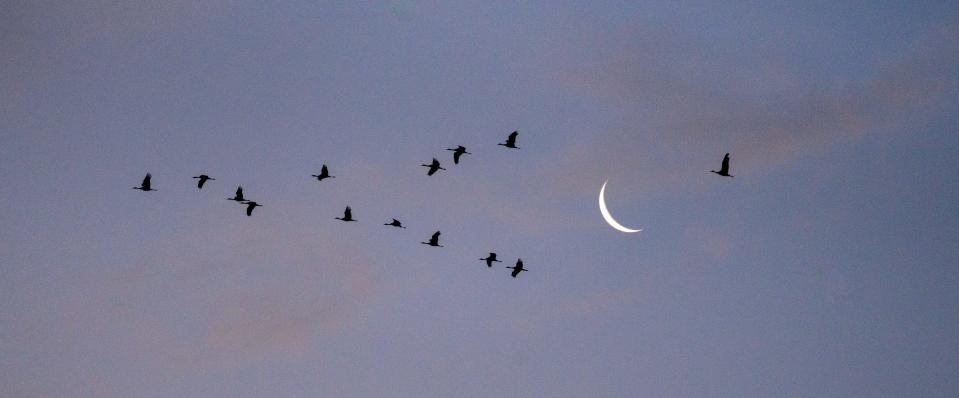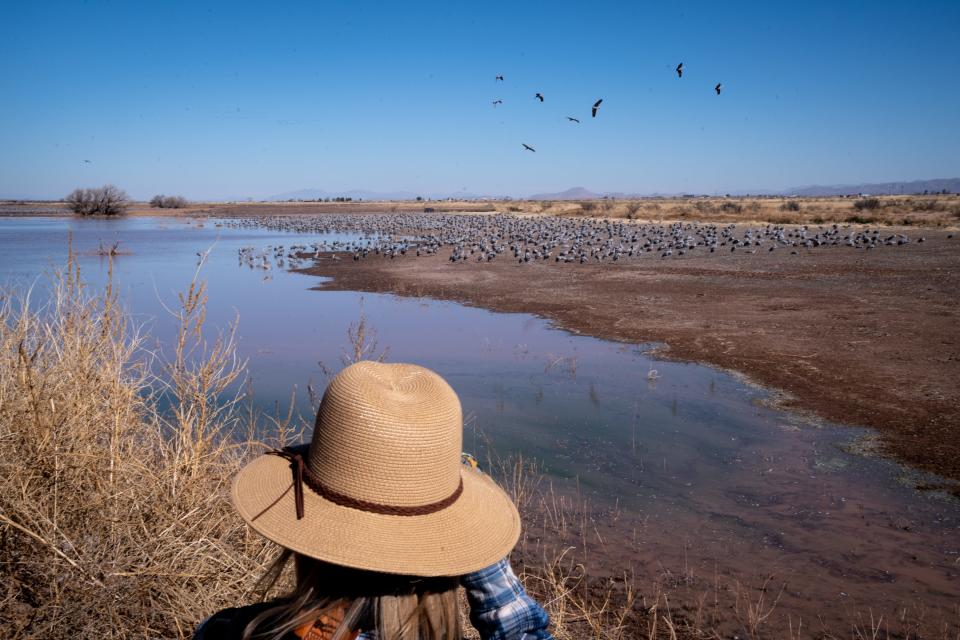Sandhill cranes flock to southern Arizona, giving nature buffs a 'magnificent sight'
McNEAL — A crescent moon hung over the dirt parking strip as dawn approached on this Saturday morning in January. Dust drifted through beams of light from vehicles on the unpaved road, giving visitors a glimpse of the scene.
“No rush, folks,” said a voice, slicing through the chatter. “We’ve got time.”
The visitors followed the voice and found Cheyenne Dubiach, wildlife viewing program coordinator for the Arizona Game and Fish Department, along with her colleague, photographer George Andrejko.
Bundled in parkas, scarves and mittens, the visitors were eager to get started, and they listened to Andrejko’s instructions.
“Thanks for coming. Thanks for participating,” he said. “We’re going to follow each other and go back out to Davis Road.” He told them what they might see once they reached their destination, talked about early morning light and how it would affect the shutter speed and F-stops on cameras.
These visitors were hunting for the perfect shot, but not with weapons. Instead, they held high-powered cameras and Andrejko was their maestro, conducting them on a search for the photogenic species of the Whitewater Draw Wildlife Area in southern Arizona.
Since 2019, with a brief hiatus in 2020 due to COVID-19, the state agency has led visitors, for a fee of $50, on a guided photography tour of the area. Jeff Meyers, the wildlife viewing program manager with the department, joined Dubiach and Andrejko to take the lead on this morning.
Dozens of species, ranging from javelina to coyote and from eared grebes to gopher snakes, live in this 1,500-acre watery ecosystem. But the biggest stars, both in stature and popularity, are the Sandhill cranes that roost here between October and March.

Every morning in winter, they take flight from the wildlife area to forage in nearby fields and return in the afternoon, offering photographers a unique opportunity to photograph the birds on their daily commute. From the meeting spot, the photo group would end up right under the flight path of the cranes.
With the moon still high, the sun started to peer behind the horizon, contrasting light and dark giving photographers a once-in-a-lifetime shot of the cranes flying against the pinks, oranges and purples of the dawn. Clouds blotched the sky, reflecting the rosy hue back into camera lenses.
“We paid extra for the clouds,” Andrejko joked of the painting-like scene. “Jeff spent all day painting those.”
Remote and surrounded by farms with abundant sources of food, the draw is an ideal spot for Sandhill cranes. The area's marshy waters offer cover from predators at night and, since Game and Fish acquired the land in 1998, humans in the day.
The cranes' penchant for the routine guarantees good wildlife viewing and great photos, which is why the tours have been so successful. Twenty-five people, the agency's limit on this in-person event, registered and attended. Tickets sold out in less than a day, with the proceeds going directly to the area's preservation.
"It's always just amazing and just mind-boggling," Andrejko said while watching the flocks of Sandhill cranes. "And what I tried to relate to the participants was, it's exciting and you get wound up in it all, but stop, take a break, take a breath, let go of your camera (so to speak) and take a look around and try to take in the bigger scope and the big picture to see the amazement of it all."
The trumpets of the cranes
Drawn to the warmer weather and constant food, Sandhill cranes have migrated to this wetland, in the middle of the Chihuahuan Desert, since at least the 1960s. Every winter, thousands of the prehistoric-like birds journey hundreds of miles down from the northern Rockies and even Canada.
The agency estimates that more than 30,000 cranes landed in the draw this season. They make up a subgroup of a larger population of more than 40,000 that flocked to the Sulphur Springs Valley this year, one of the largest flocks, according to Game and Fish. The valley functions as a drainage for the surrounding mountains, which creates the marsh habitat the cranes love.
With nearly six-foot wingspans, they are easily visible from the ground. They fly in perfect v-shaped formations, making their approach noticeable from miles away. Once in the air, their wings are almost motionless as the birds soar on thermal wind currents that keep their lithe bodies aloft.

If they aren't seen, they'll certainly be heard. With thousands of them, their trumpeting is almost constant. They honk during takeoff. They honk in flight. And they honk when landing. Up close, the birds are elegant and sinuous, their plumage faint shades of gray, white and tan. A bright red mask adorns their faces, cutting a vibrant strike through an otherwise drab winter landscape.
Tracy McCarthey, an avian monitoring coordinator with the department, joined Meyers, Andrejko and Dubiach to guide the group. Her experience with birds gave participants an inside window into their behavior and calls.
McCarthey said the cranes' ever-present communication is due, in part, to the fact that pairs mate for life and often form small family groups. In an effort to stay together and to warn others in-flight about their location, they're constantly communicating with each other.
"There are two vocalizations that we were hearing that morning," McCarthey said. "There was the trumpeting kind of loud call that the majority of the birds were giving, but then there was also this higher-pitched, trilled call that was actually the young birds communicating with the adults."
The birds also love to move, which some call a kind of dance. Their movements consist of bowing, leaping and wing stretching. It's a mating ritual that the birds perform when courting, according to Dan Collins, a migratory bird biologist for U.S. Fish and Wildlife Services.
Cranes' numbers have grown
Sandhill cranes are a conservation success story by any measure. By the middle of the 20th century, overhunting and habitat fragmentation were thought to be two main drivers of sandhill crane declines.
But after the 1960s, Collins said, harvest regulations, increased wetland protection and farm expansion, which ensured abundant food, led to a rise in numbers that continues to this day. The current population estimate for the birds in North America is upward of 800,000.
In Arizona, the cranes are considered a game species, which means they are allowed to be hunted. But within the confines of the draw, hunting them is prohibited, offering the birds a sanctuary to congregate and rest during their stay.

"The area behind this sign (inside bold line of map) is closed to all Sandhill Crane hunting!" read a sign tied to a barbed-wire fence along the perimeter of the area.
Meyers said the idea to host the tours came about after the agency noticed interest in its Whitewater Draw wildlife camera. During the Sandhill crane season, the livestreaming camera can draw up to 9,000 views each month. The sheer number of people tuning in each season was the catalyst for the tour.
"We knew that if we could get people there, they would really enjoy it," Meyers told The Arizona Republic. "Everyone loves when they get a good photo. So we knew that was a good opportunity to reach out to constituents and to get them involved."
Watch: Live images of sandhill cranes from the state Game and Fish Department
'A magnificent sight'
With the sun up, the Mule Mountains came into full view, offering a majestic backdrop to the fields and cottonwoods that make up the surrounding countryside. While waiting for the cranes to return, participants toured the draw with Andrejko and McCarthey. McCarthey's group played a bit of a species hunt, spotting and identifying animals listed on a handout.
Blue-winged teal, northern shoveler, northern pintail, coots and vermilion flycatchers were among some of the birds spotted among the reeds. The highlight for the group was a cooper's hawk perched on a branch and superbly camouflaged in the browns and tans of the marsh. In total, they counted 39 different species of birds on their tour.
In the late morning, the cranes started to descend back into the draw. It's at this point that the sheer size of the flock came into sharper view. When they took off, they flew in small, piecemeal groups.
On their return flight, they flew in droves, appearing as dark lines streaked across the sky. They swarmed the watery area, with some landing on the banks of the marsh before wading in to grab a drink, some plopping right into the water.
"We got to see lift-offs and fly-ins several times," said Kathy Ritter, a nature photographer from Happy Jack. "And it was amazing to see that intense number of birds, and the noise of them all taking off at the same time was just thrilling. It really was a magnificent sight."
Their telltale trumpeting could be heard from miles away. Once in view, their long legs could be seen trailing their outstretched wings. Before landing, their hitherto motionless wings flapped to release air from underneath as if they were pumping brakes on a plane.
Flocks of cranes arrived well past noon, as participants started to make their exit. As they did, the cranes loafed around the area, socializing, feeding and appearing to enjoy what seemed to be down time, before finally roosting for the evening.
More tours in years to come
Meyers is already preparing for next year's tour, with plans to fine-tune the event and possibly host two separate trips instead of one. But most of all, he said connecting with nature will remain a priority.
For participants, it offers a chance to engage with wildlife and a natural cycle of crane migration that plays out across North America, with Arizona being a particular hotspot. To sum up the experience and its purpose, Meyers paraphrases Baba Dioum, a Senegalese forestry engineer.
"In the end, we will conserve only what we love. And we will love only what we understand. And we will understand only what we were taught," said Meyers.
"It's just a great thing. And this is why I do what I do. I left a very different career to follow my passion and my actual academic training, which is in biology, to educate people about wildlife because the more educated they are, the more likely they are to conserve it. And that's what I'm all about."
Lindsey Botts is an environmental reporter for The Arizona Republic/azcentral. Follow his reporting on Twitter at @lkbotts and Lkbotts on Instagram. Tell him about stories at lindsey.botts@azcentral.com
Environmental coverage on azcentral.com and in The Arizona Republic is supported by a grant from the Nina Mason Pulliam Charitable Trust. Follow The Republic environmental reporting team at environment.azcentral.com and @azcenvironment on Facebook, Twitter and Instagram.
Support local journalism. Start your online subscription.
This article originally appeared on Arizona Republic: Nature buffs hunt for the perfect shot of migrating Sandhill cranes

